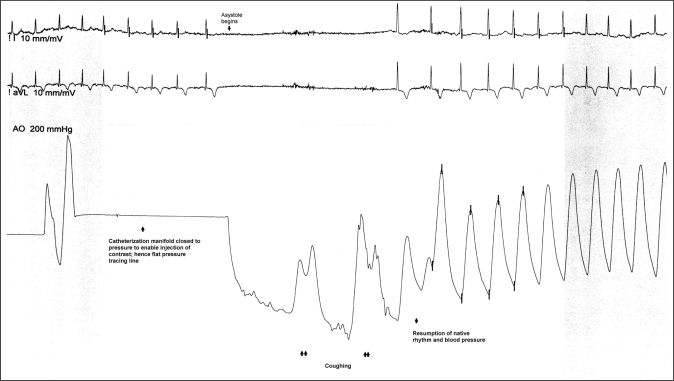Figure 1).
Cough-assisted maintenance of perfusion during asystole. When asystole began, the patient was asked to cough, yielding a recorded aortic systolic blood pressure of 80 mmHg to 100 mmHg (double arrows). Following this, the patient’s native rhythm and blood pressure resumed
A 65-year-old man underwent coronary angiography for symptoms of unstable angina. During injection of contrast into the left coronary artery, he transiently developed asystole (Figure 1). The patient was asked to cough immediately, yielding a recorded aortic systolic blood pressure of 80 mmHg to 100 mmHg. Following this, his native rhythm and blood pressure resumed. The present case illustrates the efficacy of coughing as a tool for cardiopulmonary resuscitation (CPR). Forceful coughing can maintain circulation for a brief period of time during cardiac arrest by generating sufficient blood pressure that perfuses the brain and vital organs (1). Each forceful cough abruptly raises intrathoracic pressure, forcing blood out of the chest, into the aorta and its branches. Between coughs, deep inspiration draws blood into the right heart. Thus, a circulation is established. Initiation of cough CPR at the first warning of hemodynamic collapse can maintain consciousness until conventional CPR can be delivered and, in some instances, may even terminate a lethal arrhythmia if it is the cause of the collapse. While only applicable in instances in which there is enough warning before hemodynamic catastrophe, potential uses include teaching the technique to patients with lethal arrhythmias or vasovagal syncope; the patient is able to sense the beginning of his or her event and initiate cough CPR while waiting for help. It is also very useful in the hospital setting as a means to resuscitate a monitored patient with impending hemodynamic failure, sometimes obviating the need for intubation and mechanical CPR, at least in the initial stage. Examples include an admitted patient experiencing profound bradycardia or a patient developing asystole in the cardiac catheterization laboratory (2). Therefore, cough CPR is a useful tool; it works, and is worth remembering.
Acknowledgments
The author thanks the cardiac catheterization laboratory staff at the Aga Khan University Hospital (Karachi, Pakistan) for their hard work and support.
REFERENCES
- 1.Criley JM, Blaufuss AH, Kissel GL. Cough-induced cardiac compression. Self-administered form of cardiopulmonary resuscitation. JAMA. 1976;236:1246–50. [PubMed] [Google Scholar]
- 2.Miller B, Lesnefsky E, Heyborne T, et al. Cough-cardiopulmonary resuscitation in the cardiac catheterization laboratory: Hemodynamics during an episode of prolonged hypotensive ventricular tachycardia. Cathet Cardiovasc Diagn. 1989;18:168–71. doi: 10.1002/ccd.1810180307. [DOI] [PubMed] [Google Scholar]



